Piezoelectric Properties of As-Spun Poly(vinylidene Fluoride)/Multi-Walled Carbon Nanotube/Zinc Oxide Nanoparticle (PVDF/MWCNT/ZnO) Nanofibrous Films
Abstract
:1. Introduction
2. Experiments
2.1. Electrospinning
2.2. Spinning Liquids
2.3. Sensor Assembly
2.4. Characterization and Test
3. Results and Discussion
3.1. Morphological Analysis
3.2. Crystal Structure
3.3. Piezoelectricity
4. Conclusions
- Morphologically, binary additives make nanofibers bigger. A moderate amount of binary additives may produce aligned and homogeneous nanofibers through the electrospinning process. The MWCNT content results in many nanopores left on a nanofiber’s surface after a slow volatilization of solvent. The ZnO content leads to agglomeration owing to the high surface activity of ZnO nanoparticles.
- Crystallographically, binary additives enhance crystallinity, but they slightly change the β-phase PVDF content. Naturally, the formation of β-phase PVDF crystals is dependent on the effect of stretch-enhanced polarization from the electrospinning process. Moderate amounts of MWCNTs and ZnO nanoparticles are conducive to obtain high crystallinity and high β-phase content.
- Piezoelectrically, binary additives promote the output voltage and piezoelectric voltage coefficient, since MWCNTs may construct a conductive network in the PVDF matrix and ZnO nanoparticles themselves are a piezoelectric material.
Author Contributions
Funding
Institutional Review Board Statement
Data Availability Statement
Conflicts of Interest
References
- Qureshy, A.M.M.I.; Dincer, I. A new integrated renewable energy system for clean electricity and hydrogen fuel production. Int. J. Hydrog. Energy 2020, 45, 20944–20955. [Google Scholar] [CrossRef]
- Xu, W.; Huang, L.B.; Wong, M.C.; Chen, L.; Bai, G.; Hao, J. Environmentally friendly hydrogel-based triboelectric nanogenerators for versatile energy harvesting and self-powered sensors. Adv. Energy Mater. 2017, 7, 1601529. [Google Scholar] [CrossRef]
- Yoo, H.G.; Byun, M.; Jeong, C.K.; Lee, K.J. Performance enhancement of electronic and energy devices via block copolymer self-assembly. Adv. Mater. 2015, 27, 3982–3998. [Google Scholar] [CrossRef] [PubMed]
- Zhang, K.; Wang, S.; Yang, Y. A One-structure-based piezo-tribo-pyro-photoelectric effects coupled nanogenerator for simultaneously scavenging mechanical, thermal, and solar energies. Adv. Energy Mater. 2017, 7, 1601852. [Google Scholar] [CrossRef]
- Dong, K.; Wang, Y.C.; Deng, J.; Dai, Y.; Zhang, S.L.; Zou, H.; Gu, B.; Sun, B.; Wang, Z.L. A highly stretchable and washable all-yarn-based self-charging knitting power textile composed of fiber triboelectric nanogenerators and supercapacitors. Acs Nano 2017, 11, 9490–9499. [Google Scholar] [CrossRef]
- Lai, Y.C.; Deng, J.; Zhang, S.L.; Niu, S.; Guo, H.; Wang, Z.L. Single-thread-based wearable and highly stretchable triboelectric nanogenerators and their applications in cloth-based self-powered human-interactive and biomedical sensing. Adv. Funct. Mater. 2017, 27, 1604462. [Google Scholar] [CrossRef]
- Yuan, H.; Lei, T.; Qin, Y.; Yang, R. Flexible electronic skins based on piezoelectric nanogenerators and piezotronics. Nano Energy 2019, 59, 84–90. [Google Scholar] [CrossRef]
- He, Z.; Mohsenzadeh, E.; Zhang, S.; Rault, F.; Salaün, F. Development of high-sensitive piezoelectric nanogenerators of all-organic PVDF multilayer nanofibrous membrane with innovative 3D structure via electrohydrodynamic processes. J. Polym. Res. 2023, 30, 385. [Google Scholar] [CrossRef]
- Wang, N.; Dou, W.; Hao, S.; Cheng, Y.; Zhou, D.; Huang, X.; Jiang, C.; Cao, X. Tactile sensor from self-chargeable piezoelectric supercapacitor. Nano Energy 2019, 56, 868–874. [Google Scholar] [CrossRef]
- Feng, H.; Zhao, C.; Tan, P.; Liu, R.; Chen, X.; Li, Z. Nanogenerator for biomedical applications. Adv. Healthc. Mater. 2018, 7, e1701298. [Google Scholar] [CrossRef]
- Chen, Y.; Zhang, Y.; Zhang, L.; Ding, F.; Schmidt, O.G. Scalable single crystalline PMN-PT nanobelts sculpted from bulk for energy harvesting. Nano Energy 2017, 31, 239–246. [Google Scholar] [CrossRef]
- He, Z.; Rault, F.; Lewandowski, M.; Mohsenzadeh, E.; Salaün, F. Electrospun PVDF nanofibers for piezoelectric applications: A review of the influence of electrospinning parameters on the β phase and crystallinity enhancement. Polymers 2021, 13, 174. [Google Scholar] [CrossRef] [PubMed]
- He, Z.; Rault, F.; Vishwakarma, A.; Mohsenzadeh, E.; Salaün, F. High-aligned PVDF nanofibers with a high electroactive phase prepared by systematically optimizing the solution property and process parameters of electrospinning. Coatings 2022, 12, 1310. [Google Scholar] [CrossRef]
- Zhang, P.; Zhang, W.; Zhang, H. A triboelectric nanogenerator based on waste Polyvinyl chloride for Morse code generator. Sens. Actuators A Phys. 2021, 322, 112633. [Google Scholar] [CrossRef]
- Martins, P.; Lopes, A.C.; Lanceros-Mendez, S. Electroactive phases of poly(vinylidene fluoride): Determination, processing and applications. Prog. Polym. Sci. 2014, 39, 683–706. [Google Scholar] [CrossRef]
- Yu, H.; Huang, T.; Lu, M.; Mao, M.; Zhang, Q.; Wang, H. Enhanced power output of an electrospun PVDF/MWCNTs-based nanogenerator by tuning its conductivity. Nanotechnology 2013, 24, 405401. [Google Scholar] [CrossRef]
- Ruan, L.X.; Yao, X.N.; Chang, Y.F.; Zhou, L.; Qin, G.; Zhang, X. Properties and applications of the β phase poly(vinylidene fluoride). Polymers 2018, 10, 228. [Google Scholar] [CrossRef]
- Cui, Z.; Hassankiadeh, N.T.; Zhuang, Y.; Drioli, E.; Lee, Y.M. Crystalline polymorphism in poly(vinylidenefluoride) membranes. Prog. Polym. Sci. 2015, 51, 94–126. [Google Scholar] [CrossRef]
- Lin, B.; Chen, G.D.; He, F.A.; Li, Y.; Yang, Y.; Shi, B.; Feng, F.-R.; Chen, S.-Y.; Lam, K.-H. Preparation of MWCNTs/PVDF composites with high-content β form crystalline of PVDF and enhanced dielectric constant by electrospinning-hot pressing method. Diam. Relat. Mater. 2023, 131, 109556. [Google Scholar] [CrossRef]
- Singh, V.; Singh, B. Fabrication of PVDF-transition metal dichalcogenides based flexible piezoelectric Nanogenerator for energy harvesting applications. Mater. Today Proc. 2020, 28, 282–285. [Google Scholar] [CrossRef]
- Parangusan, H.; Bhadra, J.; Al-Thani, N. Flexible piezoelectric nanogenerator based on [P(VDF-HFP)]/ PANI-ZnS electrospun nanofibers for electrical energy harvesting. J. Mater. Sci-Mater. El 2021, 32, 6358–6368. [Google Scholar] [CrossRef]
- Liu, J.; Yang, B.; Lu, L.; Wang, X.; Li, X.; Chen, X.; Liu, J. Flexible and lead-free piezoelectric nanogenerator as self-powered sensor based on electrospinning BZT-BCT/P(VDF-TrFE) nanofibers. Sens. Actuat. A-Phys. 2020, 303, 111796. [Google Scholar] [CrossRef]
- Li, J.; Zhao, C.; Xia, K.; Liu, X.; Li, D.; Han, J. Enhanced piezoelectric output of the PVDF-TrFE/ZnO flexible piezoelectric nanogenerator by surface modification. Appl. Surf. Sci. 2019, 463, 626–634. [Google Scholar] [CrossRef]
- Nega, C.; Ramin, K.; Ali, A.Y.; Rashidi, A.; Golestanifard, F. A flexible piezoelectric pressure sensor based on PVDF nanocomposite fibers doped with PZT particles for energy harvesting applications. Ceram. Int. 2020, 46, 19669–19681. [Google Scholar]
- Zhang, M.; Liu, C.; Li, B.; Shen, Y.; Wang, H.; Ji, K.; Mao, X.; Wei, L.; Sun, R.; Zhou, F. Electrospun PVDF-based piezoelectric nanofibers: Mate-rials, structures, and applications. Nanoscale Adv. 2023, 5, 1043–1059. [Google Scholar] [CrossRef]
- Li, J.; Chen, S.; Liu, W.; Fu, R.; Tu, S.; Zhao, Y.; Dong, L.; Yan, B.; Gu, Y. High performance piezoelectric nanogenerators based on electrospun ZnO nanorods/poly(vinylidene fluoride) composite membranes. J. Phys. Chem. C 2019, 123, 11378–11387. [Google Scholar] [CrossRef]
- Wang, A.; Hu, M.; Zhou, L.; Qiang, X. Self-Powered wearable pressure sensors with enhanced piezoelectric properties of aligned P(VDF-TrFE)/MWCNT composites for monitoring human physiological and muscle motion signs. Nanomaterials 2018, 8, 1021. [Google Scholar] [CrossRef]
- Pratihar, S.; Patra, A.; Sasmal, A.; Medda, S.K.; Sen, S. Enhanced dielectric, ferroelectric, energy storage and mechanical energy harvesting performance of ZnO–PVDF composites induced by MWCNTs as an additive third phase. Soft Matter 2021, 17, 8483–8495. [Google Scholar] [CrossRef]
- Kumar, A.; Jaiswal, S.; Joshi, R.; Yadav, S.; Dubey, A.; Sharma, D.; Lahiri, D.; Lahiri, I. Energy harvesting by piezoelectric polyvinylidene fluoride/zinc oxide/carbon nanotubes composite under cyclic uniaxial tensile deformation. Polym. Compos. 2023, 44, 4746–4756. [Google Scholar] [CrossRef]
- Khalifa, M.; Peravali, S.; Varsha, S.; Anandhan, S. Piezoelectric energy harvesting using flexible self-poled electroactive nanofabrics based on PVDF/ZnO-decorated SWCNT nanocomposites. JOM 2022, 74, 3162–3171. [Google Scholar] [CrossRef]
- Reneker, D.H.; Yarin, A.L. Electrospinning jets and polymer nanofibers. Polymer 2008, 49, 2387–2425. [Google Scholar] [CrossRef]
- Li, D.; Xia, Y.N. Electrospinning of nanofibers: Reinventing the wheel? Adv. Mater. 2004, 16, 1151–1170. [Google Scholar] [CrossRef]
- Abolhasani, M.M.; Shirvanimoghaddam, K.; Naebe, M. PVDF/graphene composite nanofibers with enhanced piezoelectric performance for development of robust nanogenerators. Compos. Sci. Technol. 2017, 138, 49–56. [Google Scholar] [CrossRef]
- Gregorio, R.G., Jr. Determination of the α, β, and γ crystalline phases of poly(vinylidene fluoride) films prepared at different conditions. J. Appl. Polym. Sci. 2010, 100, 3272–3279. [Google Scholar] [CrossRef]
- Kabir, E.; Khatun, M.; Nasrin, L.; Raihan, M.J.; Rahman, M. Pure β-phase formation in polyvinylidene uoride (PVDF)-carbon nanotube composites. J. Phys. D Appl. Phys. 2017, 50, 163002. [Google Scholar] [CrossRef]
- Mohamadi, S.; Sharifi-Sanjani, N. Crystallization of PVDF in graphene-filled electrospun PVDF/PMMA nanofibers processed at three different conditions. Fiber Polym. 2016, 17, 582–592. [Google Scholar] [CrossRef]
- Singh, H.H.; Khare, N. Flexible ZnO-PVDF/PTFE based piezo-tribo hybrid nanogenerator. Nano Energy 2018, 51, 216–222. [Google Scholar] [CrossRef]
- Yousefi, A.A. Influence of polymer blending on crystalline structure of polyvinylidene fluoride. Iran. Polym. J. 2011, 20, 109–121. [Google Scholar]
- Salimi, A.; Yousefi, A.A. FTIR studies of beta-phase crystal formation in stretched PVDF films. Polym. Test. 2003, 22, 699–704. [Google Scholar] [CrossRef]
- Li, G.Y.; Zhang, H.D.; Guo, K.; Ma, X.S.; Long, Y.Z. Fabrication and piezoelectric-pyroelectric properties of electrospun PVDF/ZnO composite fibers. Mater. Res. Express 2020, 7, 095502. [Google Scholar] [CrossRef]
- Mahanty, B.; Ghosh, S.K.; Maity, K.; Roy, K.; Sarkar, S.; Mandal, D. All-fiber pyro- and piezo-electric nanogenerator for IoT based self-powered health-care monitoring. Mater. Adv. 2021, 2, 4370–4379. [Google Scholar] [CrossRef]
- Thakur, P.; Kool, A.; Hoque, N.A.; Bagchi, B.; Khatun, F.; Biswas, P.; Brahma, D.; Roy, S.; Banerjee, S.; Das, S. Superior performances of in situ synthesized ZnO/PVDF thin film based self-poled piezoelectric nanogenerator and self-charged photo-power bank with high durability. Nano Energy 2017, 44, 456–467. [Google Scholar] [CrossRef]
- Sun, H.; Tian, H.; Yang, Y. A novel flexible nanogenerator made of ZnO nanoparticles and multiwall carbon nanotube. Nanoscale 2013, 5, 6117–6123. [Google Scholar] [CrossRef] [PubMed]
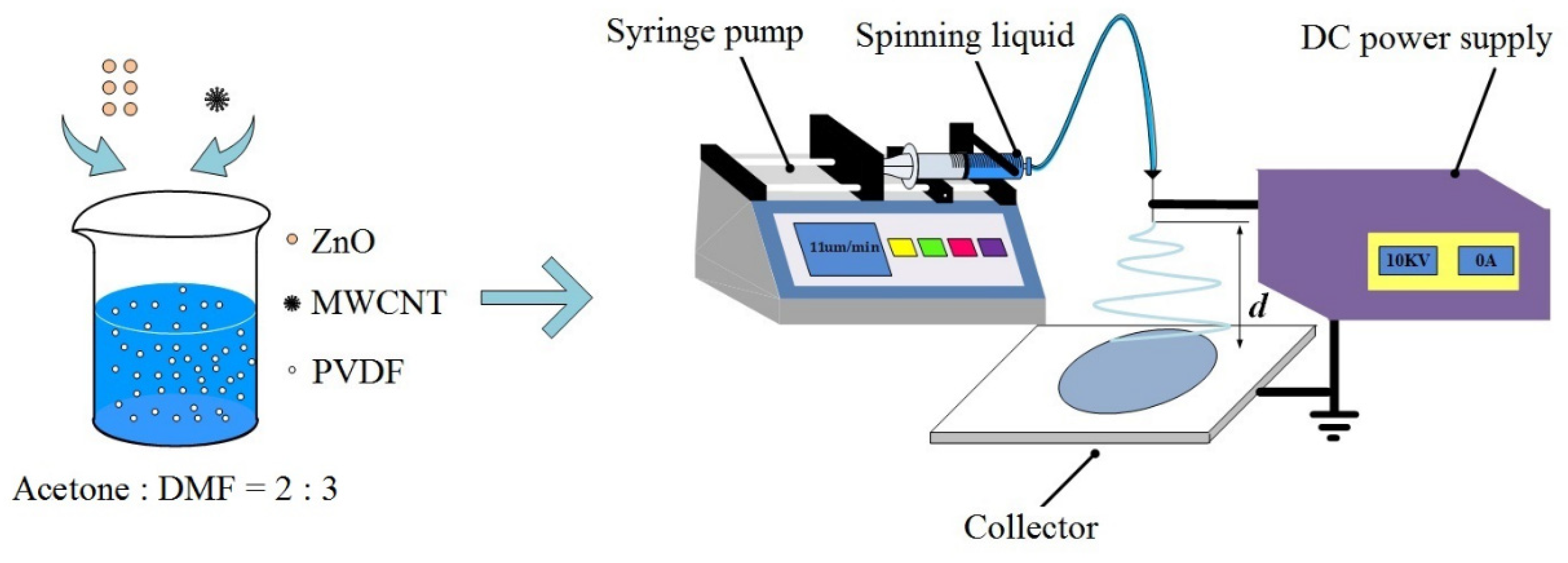



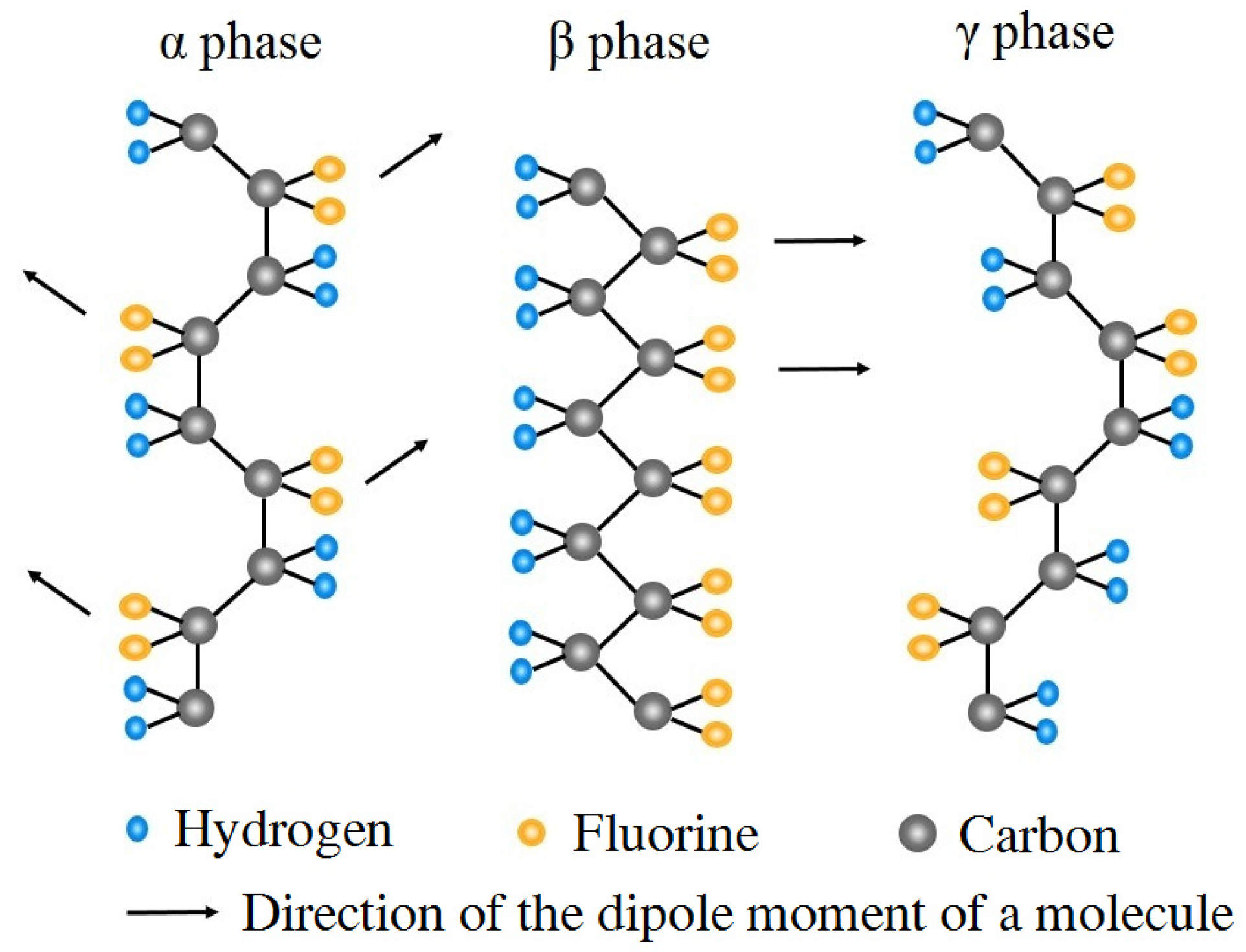

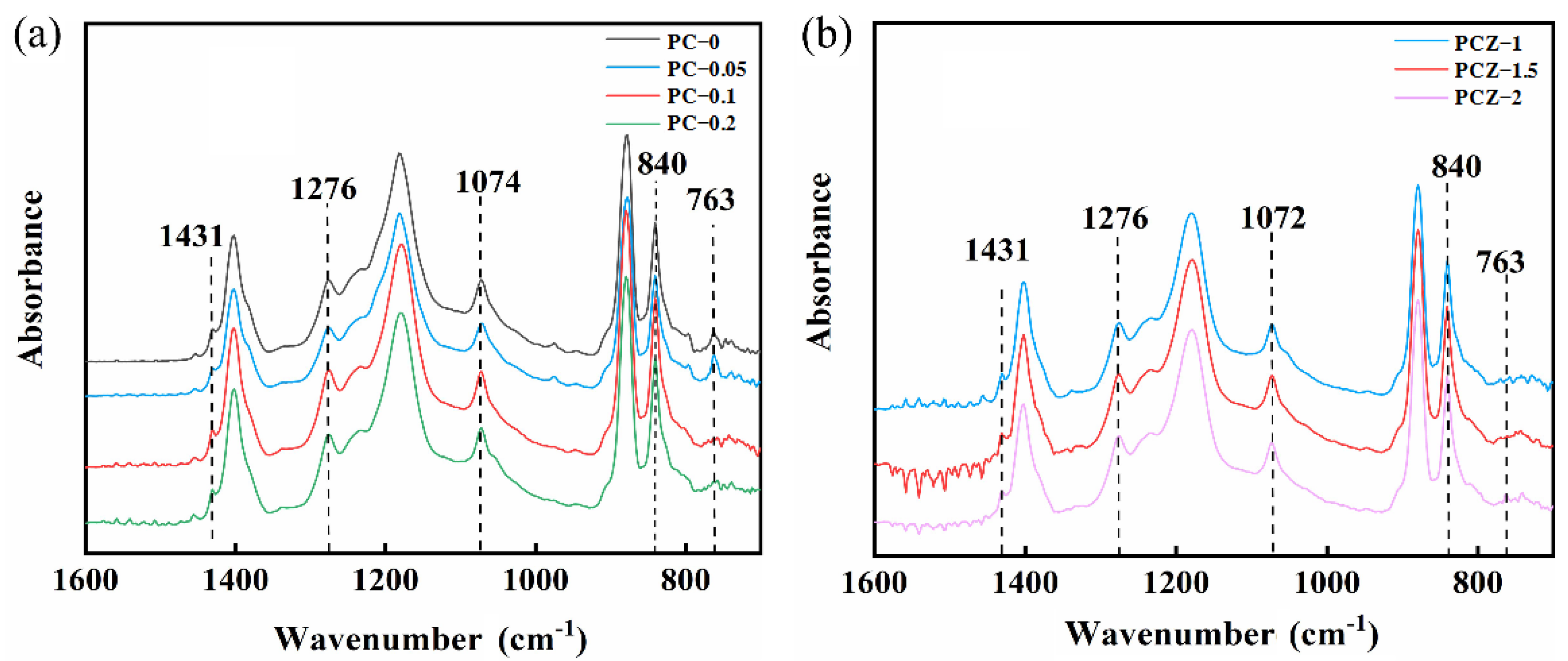
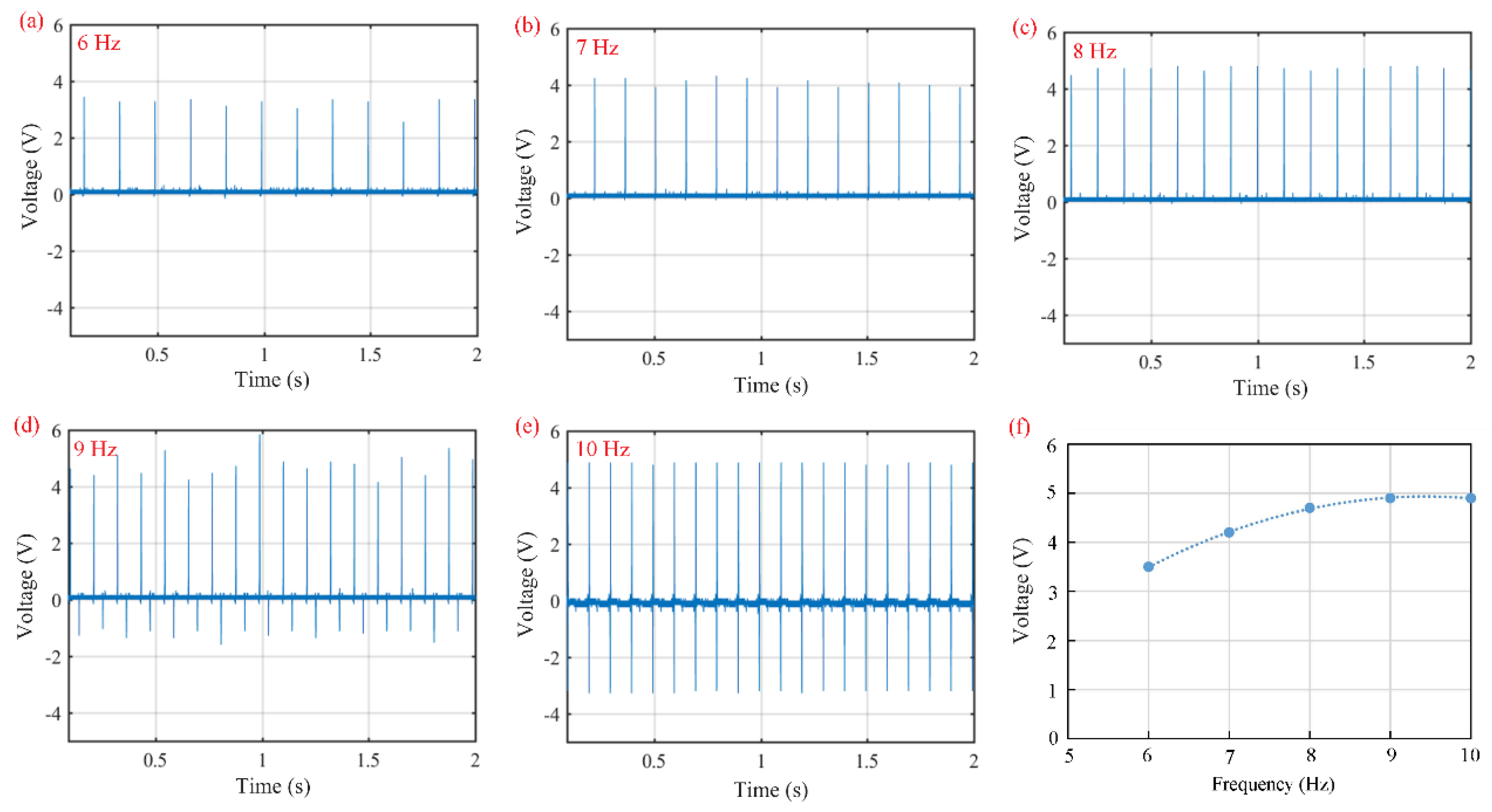

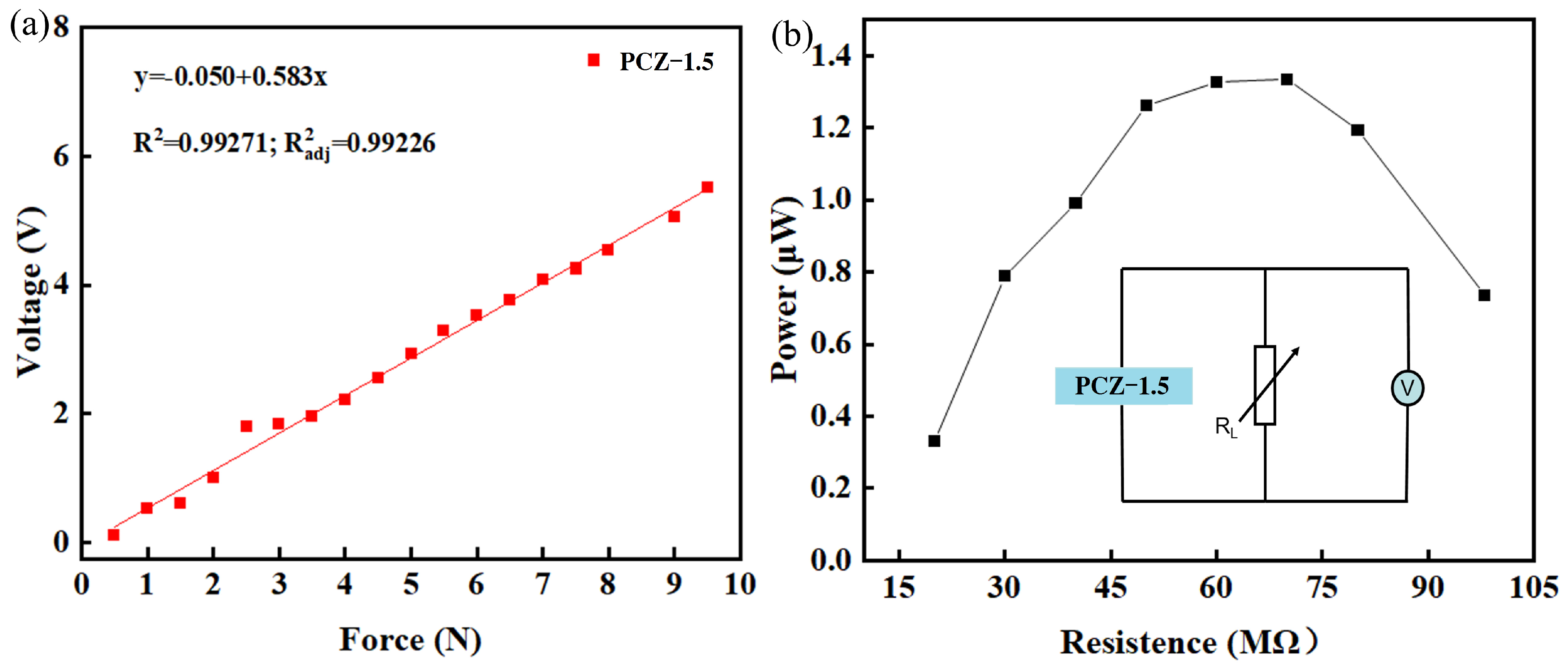
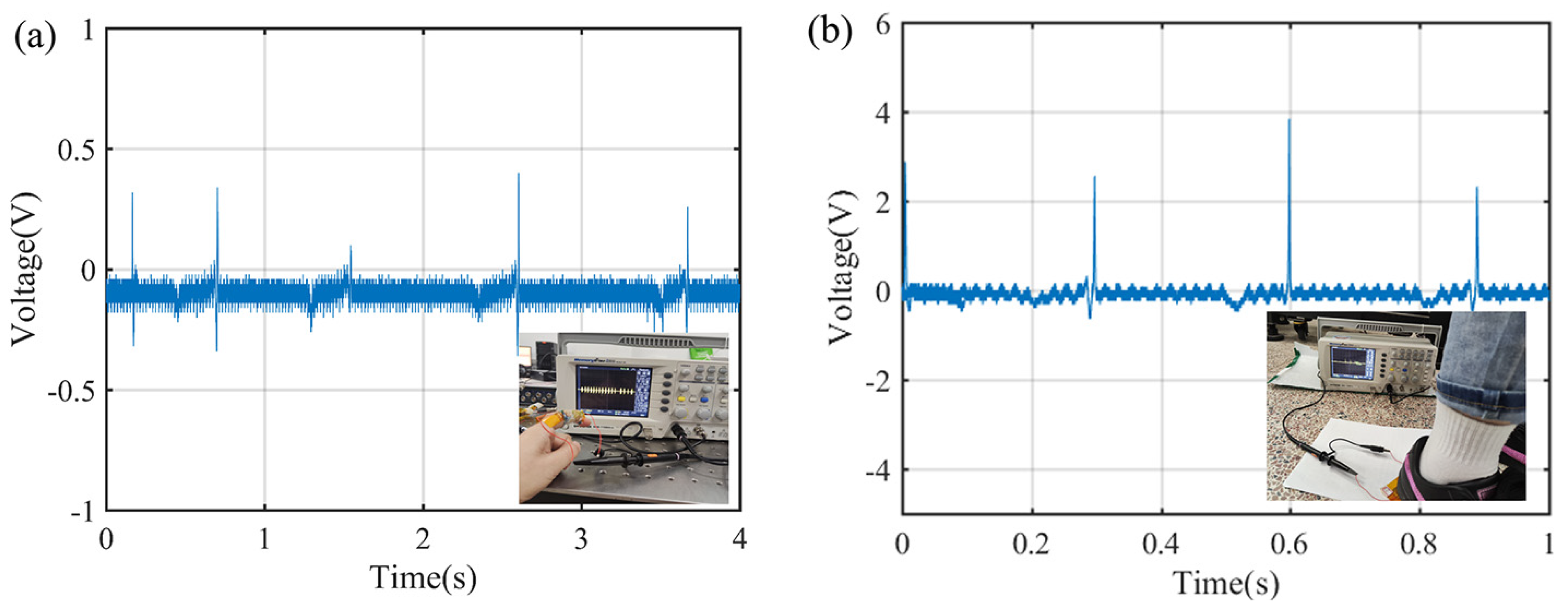
| Spinning Liquid | Solvent | Solute in Solvent (by Mass) | Additives in Solvent (by Mass) |
|---|---|---|---|
| PC–0 | Acetone–DMF (40:60 vol %) | 10% PVDF | None |
| PC–0.05 | 0.05% MWCNTs | ||
| PC–0.1 | 0.1% MWCNTs | ||
| PC–0.2 | 0.2% MWCNTs | ||
| PCZ–1 | 0.1% MWCNTs and 1.0% ZnO | ||
| PCZ–1.5 | 0.1% MWCNTs and 1.5% ZnO | ||
| PCZ–2 | 0.1% MWCNTs and 2.0% ZnO |
| Film | B-Phase Content (%) | Crystallinity (%) |
|---|---|---|
| PC–0 | 76.6 | 42.7 |
| PC–0.05 | 67.3 | 55.5 |
| PC–0.1 | 77.4 | 70.4 |
| PC–0.2 | 69.7 | 51.4 |
| PCZ–1 | 73.8 | 67.5 |
| PCZ–1.5 | 79.0 | 87.9 |
| PCZ–2 | 77.1 | 67.0 |
| Solution | Additives | Fabrication | B-Phase Content | Crystallinity | Output Power | Reference |
|---|---|---|---|---|---|---|
| 10 wt % PVDF | 5 wt % MWCNTs | Electrospinning | 68.4% | 38.1% | 81.8 nW for charging a capacitor | [16] |
| 22 wt % PVDF | 5 wt % ZnO | Electrospinning | / | / | 10 μW/cm2 under impact loads of 5 N at 0.4 Hz | [40] |
| 1.35 g PVDF in 10 mL of solvent | 0.75 wt % ZnO-decorated SWCNTs | Electrospinning | 95% | 36.1% | 8.1 μW/cm2 at 10 MΩ load resistance | [30] |
| 8 wt % PVDF | 0.1 wt % MWCNTs, 15 wt % ZnO | Drop casting | 88.9% (Electroactive phase) | 32.4% | 21.41 μW/cm2 at 4 MΩ load resistance | [28] |
| 2 g PVDF in 10 mL of solvent | 1.5 wt % CNTs, 15 wt % ZnO | Solution casting | 62% | 51.16% | 0.66 μW for bending of legs, arms, and wrist | [29] |
Disclaimer/Publisher’s Note: The statements, opinions and data contained in all publications are solely those of the individual author(s) and contributor(s) and not of MDPI and/or the editor(s). MDPI and/or the editor(s) disclaim responsibility for any injury to people or property resulting from any ideas, methods, instructions or products referred to in the content. |
© 2024 by the authors. Licensee MDPI, Basel, Switzerland. This article is an open access article distributed under the terms and conditions of the Creative Commons Attribution (CC BY) license (https://creativecommons.org/licenses/by/4.0/).
Share and Cite
Xu, L.; Lv, J.; Yu, S. Piezoelectric Properties of As-Spun Poly(vinylidene Fluoride)/Multi-Walled Carbon Nanotube/Zinc Oxide Nanoparticle (PVDF/MWCNT/ZnO) Nanofibrous Films. Polymers 2024, 16, 2483. https://doi.org/10.3390/polym16172483
Xu L, Lv J, Yu S. Piezoelectric Properties of As-Spun Poly(vinylidene Fluoride)/Multi-Walled Carbon Nanotube/Zinc Oxide Nanoparticle (PVDF/MWCNT/ZnO) Nanofibrous Films. Polymers. 2024; 16(17):2483. https://doi.org/10.3390/polym16172483
Chicago/Turabian StyleXu, Lei, Jiao Lv, and Shengrui Yu. 2024. "Piezoelectric Properties of As-Spun Poly(vinylidene Fluoride)/Multi-Walled Carbon Nanotube/Zinc Oxide Nanoparticle (PVDF/MWCNT/ZnO) Nanofibrous Films" Polymers 16, no. 17: 2483. https://doi.org/10.3390/polym16172483






